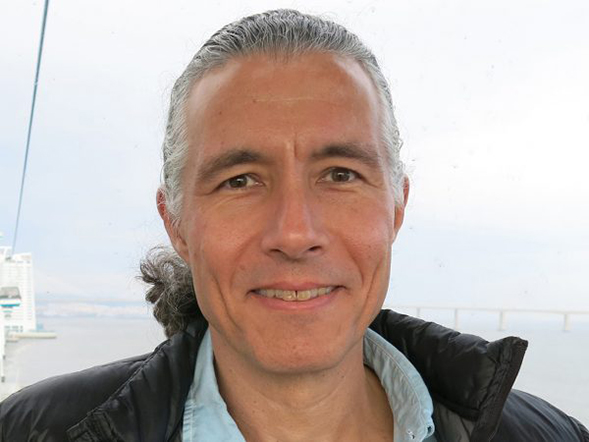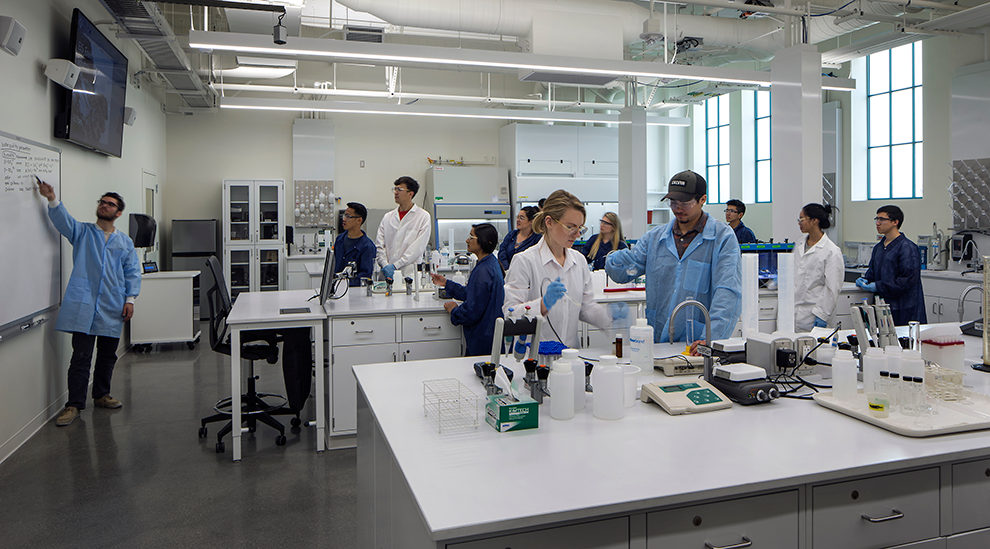SDSU's Brain Imaging Pioneer
Newly hired psychologist Martin Sereno will direct SDSU's first ever brain imaging center.

“The new imaging facility will provide our faculty with greater access to cutting-edge brain imaging equipment and techniques...”
The folds of the human cerebral cortex are deep and meandering—not unlike the path through ceiling-high stacks of unopened boxes one must currently navigate to see Martin Sereno, SDSU’s newly hired director of the under-construction brain imaging facility. He hasn’t finished unpacking, but he’s already making big plans for the university’s first ever MRI machine.
Having its own machine will help SDSU’s students and faculty in a variety of ways. For one thing, it puts the university on equal technological footing with other institutions with highly regarded psychology and neuroscience programs.
“Once you have your own magnet, you don’t have to be the second wheel,” Sereno said. “It changes the balance of power.”
It also will eventually help university faculty be more competitive for grant funding productive in their research, said Stephen Welter, SDSU’s vice president for research and dean of graduate affairs.
“The new imaging facility will provide our faculty with greater access to cutting-edge brain imaging equipment and techniques to help advance topics as diverse as autism in children, the development of fetal alcohol syndrome, neural reorganization in stroke victims, or how language skills are acquired, processed, and understood in both impaired and unpaired populations,” he said.
And perhaps most importantly, having one’s own MRI machine encourages the kinds of novel experimentation that can lead to big breakthroughs in basic and applied science, he said. When you have to go through the trouble of using someone else’s machine, your work tends to be more conservative, tried-and-true.
“When you have it on your campus, just down the hall, you can just play,” Sereno said. “You can try something just to see what happens. You can be more creative, test new ideas.”
Brain pioneer
MRI machines use a combination of radio waves and large, powerful electromagnets to excite and then detect signals from resonating hydrogen atoms like those in water. The machines then convert these signals into an image. Since the human body is mostly water, MRI machines can return images of soft tissue within the body.
The modern field of brain imaging is predicated upon a relatively recent application of MRI called functional MRI, or fMRI, which measures the oxygenation of blood flowing through each small region of the brain. Because the brain very rapidly and precisely delivers extra oxygen to any part of the brain that becomes active, scientists can use this information to figure out which regions of the brain are active for just about any kind of cognitive activity you can do in the magnet while keeping your head still.
Sereno, a psychologist and cognitive neuroscientist, is a pioneering figure within the world of fMRI. While he was working at the University of California, San Diego, in the 1990s—mere years after the technology had first been introduced—Sereno and colleague Anders Dale developed the first software to accurately and automatically reconstruct the cortical surface from brain images in order to map out brain activation. That freely available software, FreeSurfer, remains one of the most widely used tools to analyze cortical fMRI readings.
Sereno worked at UCSD for almost 20 years at its brain imaging centers until 2007. At that point, he and his wife, artist Claudia Fernety, moved to London, where Sereno directed the Neuroimaging Center for the psychology departments at University College London and Birkbeck College of London. He returned to San Diego earlier this year to join SDSU’s faculty.
“The successful recruitment of Dr. Martin Sereno, who has pioneered new neuroimaging approaches, provides SDSU with a wonderful opportunity to help synergize faculty strengths across the campus in clinical and cognitive neurosciences,” Welter said.
Bridging disciplines
As a researcher, Sereno has used fMRI to explore visual maps in the brain that initially come from the retina, as well as the brain’s auditory and somatosensory maps. His research in those areas has been published in top journals like Science, Nature and Nature Neuroscience. The beauty of fMRI lies within the sheer breadth of its uses, he added.
“If you look at the range of things you can do with fMRI, it’s pretty broad,” he said. “Compared to some other imaging technologies, there’s a lot you can do. And as a technology, it’s not done yet.”
Until now, SDSU faculty and students who wanted to do experiments with fMRI had to use MRI machines at other universities, most commonly those at UCSD. But SDSU’s Engineering and Interdisciplinary Sciences (EIS) Complex, which is scheduled to be completed in January 2018, will host the university’s very own MRI machine. The machine, a 3T Prisma made by Siemens, is scheduled to be installed in 2017. The EIS Complex itself passed a major milestone this week when construction topped out.
SDSU’s machine features a 12-ton magnet containing a superconducting coil that can maintain an electrical current on its own for more than 10 years. Sereno knows that doing interesting research with MRI machines is only half the job; the other half is keeping the complex, sometimes finicky machines and all the stimulus and response equipment running. And the key to that, largely, is staying organized and preventing people from tripping over all the wires.
“I’ve gotten quite friendly with cable ties,” Sereno said. “I have thousands of them to hold things together.”
Sereno will also feel at home working in the EIS Complex. He was bridging disciplines long before “interdisciplinary” became a buzzword. With an undergraduate degree in geology, a doctorate in neuroanatomy and a longstanding research interest in the philosophy of science, Sereno sees the value in knowing at least a little bit about what those around you are working on. For years, Sereno has taught a course aimed at neuroscientists and psychologists on the physics underlying MRI technology, as well as a systems neuroscience course aimed at psychologists, engineers and physicists. He’ll be starting teaching those courses at SDSU in the spring semester in 2017.
“Physicists and psychologists who know a little of each other’s science will be able to answer different and more interesting questions than those who don’t,” Sereno said.



